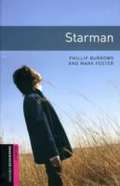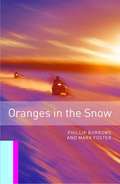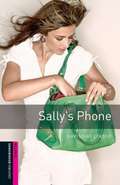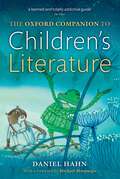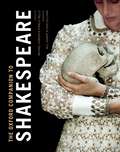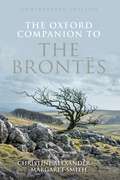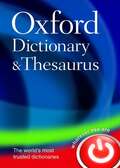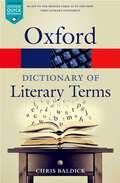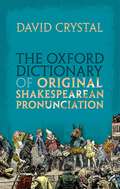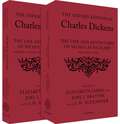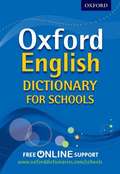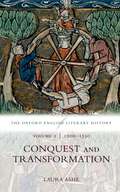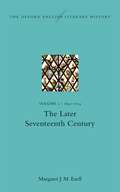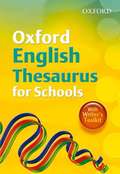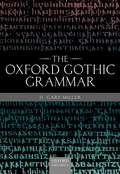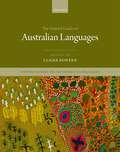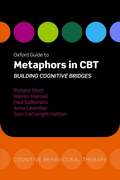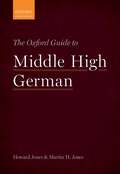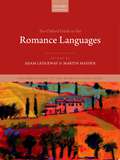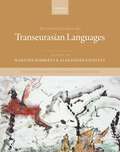- Table View
- List View
Oxford Bookworms Library, Starter: Starman (2007 edition) (PDF)
by Burrows, Phillip|Foster, MarkThe Oxford Bookworms Library offers enjoyable reading at seven levels (Starter to Stage 6). To find your required reading level please take the Oxford Bookworks reading level test. The empty centre of Australia. The sun is hot and there are not many people. And when Bill meets a man, alone, standing on an empty road a long way from anywhere, he is surprised and worried. And Bill is right to be worried. Because there is something strange about the man he meets. Very strange...
Oxford Bookworms Library, Starter: Oranges in the Snow (2007 edition) (PDF)
by Burrows, Phillip|Foster, MarkThe Oxford Bookworms Library offers enjoyable reading at seven levels (Starter to Stage 6). To find your required reading level please take the Oxford Bookworks reading level test. 'Everything's ready now. We can do the experiment,' says your assistant Joe. You are the famous scientist Mary Durie working in a laboratory in Alaska. When you discover something very new and valuable, other people want to try to steal your idea - can you stop them before they escape?
Oxford Bookworms Library, Starter: New York Café (2007 edition)
by Michael DeanThe Oxford Bookworms Library offers enjoyable reading at seven levels (Starter to Stage 6). To find your required reading level please take the Oxford Bookworks reading level test. It is the year 2030, and an e-mail message arrives at New York Café. 'I want to help people and make them happy!' But not everybody is happy about the e-mail, and soon the police and the President are very interested in the New York Café.
Oxford Bookworms Library, Starter: New York Café (2007 edition)
by Michael DeanThe Oxford Bookworms Library offers enjoyable reading at seven levels (Starter to Stage 6). To find your required reading level please take the Oxford Bookworks reading level test. It is the year 2030, and an e-mail message arrives at New York Café. 'I want to help people and make them happy!' But not everybody is happy about the e-mail, and soon the police and the President are very interested in the New York Café.
Oxford Bookworms Library, Starter: Sally's Phone (2007 edition) (PDF)
by Christine LindopThe Oxford Bookworms Library offers enjoyable reading at seven levels (Starter to Stage 6). To find your required reading level please take the Oxford Bookworks reading level test. Sally is always running - and she has her phone with her all the time: at home, on the train, at work, at lunchtime, and at the shops. But then one afternoon suddenly she has a different phone ... and it changes her life.
Oxford Bookworms Library, Starter: Sally's Phone (2007 edition) (PDF)
by Christine LindopThe Oxford Bookworms Library offers enjoyable reading at seven levels (Starter to Stage 6). To find your required reading level please take the Oxford Bookworks reading level test. Sally is always running - and she has her phone with her all the time: at home, on the train, at work, at lunchtime, and at the shops. But then one afternoon suddenly she has a different phone ... and it changes her life.
The Oxford Companion to Children's Literature (Oxford Quick Reference)
by Daniel HahnThe last thirty years have witnessed one of the most fertile periods in the history of children's books: the flowering of imaginative illustration and writing, the Harry Potter phenomenon, the rise of young adult and crossover fiction, and books that tackle extraordinarily difficult subjects. The Oxford Companion to Children's Literature provides an indispensable and fascinating reference guide to the world of children's literature. Its 3,500 entries cover every genre from fairy tales to chapbooks; school stories to science fiction; comics to children's hymns. Originally published in 1983, the Companion has been comprehensively revised and updated by Daniel Hahn. Over 900 new entries bring the book right up to date. A whole generation of new authors and illustrators are showcased, with books like Dogger, The Hunger Games, and Twilight making their first appearance. There are articles on developments such as manga, fan fiction, and non-print publishing, and there is additional information on prizes and prizewinners. This accessible A to Z is the first place to look for information about the authors, illustrators, printers, publishers, educationalists, and others who have influenced the development of children's literature, as well as the stories and characters at their centre. Written both to entertain and to instruct, the highly acclaimed Oxford Companion to Children's Literature is a reference work that no one interested in the world of children's books should be without.
The Oxford Companion to Shakespeare
by Michael Dobson Stanley Wells Will Sharpe Erin SullivanThe Oxford Companion to Shakespeare is the most comprehensive reference work available on Shakespeare's life, times, works, and his 400-year global legacy. In addition to the authoritative A-Z entries, it includes nearly 100 illustrations, a chronology, a guide to further reading, a thematic contents list, and special feature entries on each of Shakespeare's works. Tying in with the 400th anniversary of Shakespeare's death, this much-loved Companion has been revised and updated, reflecting developments and discoveries made in recent years and to cover the performance, interpretation, and the influence of Shakespeare's works up to the present day. First published in 2001, the online edition was revised in 2011, with updates to over 200 entries plus 16 new entries. These online updates appear in print for the first time in this second edition, along with a further 35,000 new and revised words. These include more than 80 new entries, ranging from important performers, directors, and scholars (such as Lucy Bailey, Samuel West, and Alfredo Michel Modenessi), to topics as diverse as Shakespeare in the digital age and the ubiquity of plants in Shakespeare's works, to the interpretation of Shakespeare globally, from Finland to Iraq. To make information on Shakespeare's major works easier to find, the feature entries have been grouped and placed in a centre section (fully cross-referenced from the A-Z). The thematic listing of entries - described in the press as 'an invaluable panorama of the contents' - has been updated to include all of the new entries. This edition contains a preface written by much-lauded Shakespearian actor Simon Russell Beale. Full of both entertaining trivia and scholarly detail, this authoritative Companion will delight the browser and reward students, academics, as well as anyone wanting to know more about Shakespeare.
The Oxford Companion to the Brontës: Anniversary edition (Oxford Companions)
by Christine Alexander Margaret SmithThis special edition of The Oxford Companion to the Brontës commemorates the bicentenary of Emily Brontë's birth in July 1818 and provides comprehensive and detailed information about the lives, works, and reputations of the Brontës - the three sisters Charlotte, Emily, and Anne, their father, and their brother Branwell. Expanded entries surveying the Brontës' lives and works are supplemented by entries on friends and acquaintances, pets, literary and political heroes; on the places they knew and the places they imagined; on their letters, drawings and paintings; on historical events such as Chartism, the Peterloo Massacre, and the Ashantee Wars; on exploration, slavery, and religion. Selected entries on the characters and places in the Brontë juvenilia provide a glimpse into their early imaginative worlds, and entries on film, ballet, and musicals indicate the extent to which their works have inspired others. A new foreword to the text has been also penned by Claire Harman, award-winning writer and literary critic, and recent biographer of Charlotte Brontë. This is a unique and authoritative reference book for the research student and the general reader. The A-Z format, extensive cross-referencing, classified contents, chronologies, illustrations, and maps, both facilitate quick reference and encourage further exploration. This Companion is not only invaluable for quick searches, but a delight to browse, and an inspiration to further reading.
Oxford Dictionary And Thesaurus: (pdf)
by Judy Pearsall Oxford Dictionaries StaffThe second edition of the Oxford Dictionary and Thesaurus is the perfect language resource, combining a dictionary and thesaurus text. This means that you only have to reach for one book when you need language help. In this edition the dictionary and thesaurus texts are integrated so that the thesaurus entry for a word follows the dictionary entry directly. This is based on market research into user preferences making the dictionary accessible, clear, and easy to use. New to this edition is a centre section for crossword enthusiasts and puzzle solvers, containing hundreds of thematic word lists. With 300,000 definitions, synonyms, and antonyms, this really is the ultimate tool for anyone who loves language-based quizzes and puzzles. The Oxford Dictionary and Thesaurus also features usage notes to help you deal with tricky vocabulary and improve your writing style. The ultimate reference tool for your shelf - but not designed to stay there!
The Oxford Dictionary of Literary Terms (Oxford Quick Reference)
by Chris BaldickThe bestselling Oxford Dictionary of Literary Terms provides clear and concise definitions of the most troublesome literary terms, from abjection to zeugma. It is an essential reference tool for students of literature in any language. Now expanded and in its fourth edition, it includes increased coverage of new terms from modern critical and theoretical movements, such as feminism, schools of American poetry, Spanish verse forms, life writing, and crime fiction. It includes extensive coverage of traditional drama, versification, rhetoric, and literary history, as well as updated and extended advice on recommended further reading and a pronunciation guide to more than 200 terms. Completely revised and updated, this edition also features brand-new entries on terms such as distant reading, graphic novels, middle generation, and misery memoir. Many new bibliographies have been added to entries and recommended web links are available via a companion website.
The Oxford Dictionary of Original Shakespearean Pronunciation
by David CrystalThis dictionary is the first comprehensive description of Shakespearean original pronunication (OP), enabling practitioners to deal with any queries about the pronunciation of individual words. It includes all the words in the First Folio, transcribed using IPA, and the accompanying website hosts sound files as a further aid to pronunciation. It also includes the main sources of evidence in the texts, notably all spelling variants (along with a frequency count for each variant) and all rhymes (including those occurring elsewhere in the canon, such as the Sonnets and long poems). An extensive introduction provides a full account of the aims, evidence, history, and current use of OP in relation to Shakespeare productions, as well as indicating the wider use of OP in relation to other Elizabethan and Jacobean writers, composers from the period, the King James Bible, and those involved in reconstructing heritage centres. It will be an invaluable resource for producers, directors, actors, and others wishing to mount a Shakespeare production or present Shakespeare's poetry in original pronunciation, as well as for students and academics in the fields of literary criticism and Shakespeare studies more generally.
The Oxford Edition of Charles Dickens: The Life and Adventures of Nicholas Nickleby (The Oxford Edition of Charles Dickens)
by Charles DickensThe Life and Adventures of Nicholas Nickleby, the second volume of the new Oxford Edition of Charles Dickens, is Dickens's third novel, originally published in monthly parts between March 1838 and September 1839. Brilliantly comic, the novel quickly developed a strong strand of social criticism, exploring themes such as love and family, selfishness, work, and charity. It showcases a host of characters, from the earnest and passionate young hero Nicholas, the pathetic Smike, and the brutal schoolmaster Wackford Squeers, to sparkling minor players like John Browdie, Mrs. Squeers, Mr. Mantalini, Mr. Crummles, and the infuriatingly inept Mrs. Nickleby. Solidifying the reputation for comedy and pathos Dickens had established with The Pickwick Papers and Oliver Twist, this novel reached—and delighted—the widest audience Dickens had yet known. The manuscript of Nicholas Nickleby survives only in fragments, with the British Library, the Charles Dickens Museum, and The Rosenbach library holding substantial portions, and the Victoria and Albert Museum, the Free Library of Philadelphia, and the Morgan Library also holding pages. This edition is presented in two volumes: the text in Volume I and Essay on the Text and Notes in Volume 2. The editors have closely examined all the surviving manuscript, recovering scores of deletions and recording all variants of wording in the textual apparatus. The text is based on that of the original serial instalments; all emendations from that text are fully documented. All lifetime British editions (the Cheap, the Library, the Illustrated Library, the People's and the Charles Dickens) have been carefully collated, and all verbal variants are recorded.
Oxford English Dictionary for Schools (PDF) (400MB+)
by Oxford Dictionaries400MB+ File Request - email bookshare@rnib.org.uk to request this title by WeTransfer. The Oxford English Dictionary for Schools is easy to use with its clear signposting, accessible design, and expertly levelled look and feel. Now students can and will find the words they want fast! It has extensive vocabulary including all cross-curriculum words, so it is ideal for preparing for Controlled Assessments. It is powered by the Oxford Children's Corpus, a unique electronic database of millions of words written for children. Added extras in this dictionary are the language panels for project work, synonyms for overused words to develop wide-ranging language skills, and citations. Real example sentences from the best children's books and teenage fiction show students how to use language most effectively. There are inspiring examples from authors such as David Almond, Philip Pullman, William Golding, Anthony Horowitz, Beverley Naidoo, and many more from the curriculum reading lists.
The Oxford English Literary History: Volume I: 1000-1350: Conquest and Transformation (Oxford English Literary History)
by Laura AsheThe Oxford English Literary History is the new century's definitive account of a rich and diverse literary heritage that stretches back for a millennium and more. Each of these thirteen groundbreaking volumes offers a leading scholar's considered assessment of the authors, works, cultural traditions, events, and ideas that shaped the literary voices of their age. The series will enlighten and inspire not only everyone studying, teaching, and researching in English Literature, but all serious readers. This book describes and seeks to explain the vast cultural, literary, social, and political transformations which characterized the period 1000-1350. Change can be perceived everywhere at this time. Theology saw the focus shift from God the Father to the suffering Christ, while religious experience became ever more highly charged with emotional affectivity and physical devotion. A new philosophy of interiority turned attention inward, to the exploration of self, and the practice of confession expressed that interior reality with unprecedented importance. The old understanding of penitence as a whole and unrepeatable event, a second baptism, was replaced by a new allowance for repeated repentance and penance, and the possibility of continued purgation of sins after death. The concept of love moved centre stage: in Christ's love as a new explanation for the Passion; in the love of God as the only means of governing the self; and in the appearance of narrative fiction, where heterosexual love was suddenly represented as the goal of secular life. In this mode of writing further emerged the figure of the individual, a unique protagonist bound in social and ethical relation with others; from this came a profound recalibration of moral agency, with reference not only to God but to society. More generally, the social and ethical status of secular lives was drastically elevated by the creation and celebration of courtly and chivalric ideals. In England the ideal of kingship was forged and reforged over these centuries, in intimate relation with native ideals of counsel and consent, bound by the law. In the aftermath of Magna Carta, and as parliament grew in reach and importance, a politics of the public sphere emerged, with a literature to match. These vast transformations have long been observed and documented in their separate fields. The Oxford English Literary History: Volume 1: 1000-1350: Conquest and Transformation offers an account of these changes by which they are all connected, and explicable in terms of one another.
The Oxford English Literary History: Volume I: 1000-1350: Conquest and Transformation (Oxford English Literary History)
by Laura AsheThe Oxford English Literary History is the new century's definitive account of a rich and diverse literary heritage that stretches back for a millennium and more. Each of these thirteen groundbreaking volumes offers a leading scholar's considered assessment of the authors, works, cultural traditions, events, and ideas that shaped the literary voices of their age. The series will enlighten and inspire not only everyone studying, teaching, and researching in English Literature, but all serious readers. This book describes and seeks to explain the vast cultural, literary, social, and political transformations which characterized the period 1000-1350. Change can be perceived everywhere at this time. Theology saw the focus shift from God the Father to the suffering Christ, while religious experience became ever more highly charged with emotional affectivity and physical devotion. A new philosophy of interiority turned attention inward, to the exploration of self, and the practice of confession expressed that interior reality with unprecedented importance. The old understanding of penitence as a whole and unrepeatable event, a second baptism, was replaced by a new allowance for repeated repentance and penance, and the possibility of continued purgation of sins after death. The concept of love moved centre stage: in Christ's love as a new explanation for the Passion; in the love of God as the only means of governing the self; and in the appearance of narrative fiction, where heterosexual love was suddenly represented as the goal of secular life. In this mode of writing further emerged the figure of the individual, a unique protagonist bound in social and ethical relation with others; from this came a profound recalibration of moral agency, with reference not only to God but to society. More generally, the social and ethical status of secular lives was drastically elevated by the creation and celebration of courtly and chivalric ideals. In England the ideal of kingship was forged and reforged over these centuries, in intimate relation with native ideals of counsel and consent, bound by the law. In the aftermath of Magna Carta, and as parliament grew in reach and importance, a politics of the public sphere emerged, with a literature to match. These vast transformations have long been observed and documented in their separate fields. The Oxford English Literary History: Volume 1: 1000-1350: Conquest and Transformation offers an account of these changes by which they are all connected, and explicable in terms of one another.
The Oxford English Literary History: Volume V: 1645-1714: The Later Seventeenth Century (Oxford English Literary History)
by Margaret J. EzellThe Oxford English Literary History is the new century's definitive account of a rich and diverse literary heritage that stretches back for a millennium and more. Each of these thirteen groundbreaking volumes offers a leading scholar's considered assessment of the authors, works, cultural traditions, events, and ideas that shaped the literary voices of their age. The series will enlighten and inspire not only everyone studying, teaching, and researching in English Literature, but all serious readers. This volume covers the period 1645-1714, and removes the traditional literary period labels and boundaries used in earlier studies to categorize the literary culture of late seventeenth-century England. It invites readers to explore the continuities and the literary innovations occurring during six turbulent decades, as English readers and writers lived through unprecedented events including a King tried and executed by Parliament and another exiled, the creation of the national entity 'Great Britain', and an expanding English awareness of the New World as well as encounters with the cultures of Asia and the subcontinent. The period saw the establishment of new concepts of authorship and it saw a dramatic increase of women working as professional, commercial writers. London theatres closed by law in 1642 reopened with new forms of entertainments from musical theatrical spectaculars to contemporary comedies of manners with celebrity actors and actresses. Emerging literary forms such as epistolary fictions and topical essays were circulated and promoted by new media including newspapers, periodical publications, and advertising and laws were changing governing censorship and taking the initial steps in the development of copyright. It was a period which produced some of the most profound and influential literary expressions of religious faith from John Milton's Paradise Lost and John Bunyan's Pilgrim's Progress, while simultaneously giving rise to a culture of libertinism and savage polemical satire, as well as fostering the new dispassionate discourses of experimental sciences and the conventions of popular romance.
The Oxford English Literary History: Volume V: 1645-1714: The Later Seventeenth Century (Oxford English Literary History)
by Margaret J. EzellThe Oxford English Literary History is the new century's definitive account of a rich and diverse literary heritage that stretches back for a millennium and more. Each of these thirteen groundbreaking volumes offers a leading scholar's considered assessment of the authors, works, cultural traditions, events, and ideas that shaped the literary voices of their age. The series will enlighten and inspire not only everyone studying, teaching, and researching in English Literature, but all serious readers. This volume covers the period 1645-1714, and removes the traditional literary period labels and boundaries used in earlier studies to categorize the literary culture of late seventeenth-century England. It invites readers to explore the continuities and the literary innovations occurring during six turbulent decades, as English readers and writers lived through unprecedented events including a King tried and executed by Parliament and another exiled, the creation of the national entity 'Great Britain', and an expanding English awareness of the New World as well as encounters with the cultures of Asia and the subcontinent. The period saw the establishment of new concepts of authorship and it saw a dramatic increase of women working as professional, commercial writers. London theatres closed by law in 1642 reopened with new forms of entertainments from musical theatrical spectaculars to contemporary comedies of manners with celebrity actors and actresses. Emerging literary forms such as epistolary fictions and topical essays were circulated and promoted by new media including newspapers, periodical publications, and advertising and laws were changing governing censorship and taking the initial steps in the development of copyright. It was a period which produced some of the most profound and influential literary expressions of religious faith from John Milton's Paradise Lost and John Bunyan's Pilgrim's Progress, while simultaneously giving rise to a culture of libertinism and savage polemical satire, as well as fostering the new dispassionate discourses of experimental sciences and the conventions of popular romance.
Oxford English Thesaurus For Schools (PDF) (400MB+)
by Susan Rennie400MB+ File Request - email bookshare@rnib.org.uk to request this title by WeTransfer. This Oxford thesaurus contains thousands of synonyms, and provides help in avoiding pitfalls and overused words. It is compiled using the Oxford Children's Corpus for real vocabulary and age-appropriate sentences.
The Oxford Gothic Grammar
by D. Gary MillerThis volume provides a comprehensive reference grammar of Gothic, the earliest attested language of the Germanic family (apart from runic inscriptions), dating to the fourth century. The bulk of the extant Gothic corpus is a translation of the Bible, of which only a portion remains, and which has been the focus of most previous works. This book is the first in English to also draw on the recently discovered Bologna fragment and Crimean graffiti, original Gothic texts that provide more insights into the language. Following an overview of the history of the Goths and the origin of the Gothic language, Gary Miller explores all the major topics in Gothic grammar, beginning with the alphabet and phonology, and proceeding through subjects such as case functions, prepositions and particles, compounding, derivation, and verbal and sentential syntax. He also presents a selection of Gothic texts with notes and vocabulary, and ends with a chapter on linearization, including an overview of Gothic in its Germanic context. The Oxford Gothic Grammar will be an invaluable reference for all Indo-Europeanists, Germanic scholars, and historical linguists, from advanced undergraduate level upwards.
The Oxford Guide to Australian Languages (Oxford Guides to the World's Languages)
The Oxford Guide to Australian Languages is a wide-ranging reference work that explores the more than 550 traditional and new Indigenous languages of Australia. Australian languages have long played an important role in diachronic and synchronic linguistics and are a vital testing ground for linguistic theory. Until now, however, there has been no comprehensive and accessible guide to the their vast linguistic diversity. This volume fills that gap, bringing together leading scholars and junior researchers to provide an up-to-date guide to all aspects of the languages of Australia. The chapters in the book explore typology, documentation, and classification; linguistic structures from phonology to pragmatics and discourse; sociolinguistics and language variation; and language in the community. The final part offers grammatical sketches of a selection of languages, sub-groups, and families. At a time when the number of living Australian languages is significantly reduced even compared to twenty year ago, this volume establishes priorities for future linguistic research and contributes to the language expansion and revitalization efforts that are underway.
Oxford Guide To Metaphors In Cbt: Building Cognitive Bridges (pdf) (Oxford Guides In Cognitive Behavioural Therapy Ser.)
by Richard Stott Warren Mansell Paul Salkovskis Anna Lavender Sam Cartwright-HattonThe business of cognitive therapy is to transform meanings. What better way to achieve this than through a metaphor? Metaphors straddle two different domains at once, providing a conceptual bridge from a problematic interpretation to a fresh new perspective that can cast one's experiences in a new light. Even the simplest metaphor can be used again and again with different clients, yet still achieve the desired effect. One such example is the 'broken leg' metaphor for depression. Clients with depression are understandably frustrated with their symptoms. They may often push themselves to get better or tell themselves that they should be better by now. As a therapist, it is fair to ask, would the client be so harsh and demanding on herself after getting a broken leg? A broken leg needs time to heal and you need to begin to walk on it gradually as it builds up in strength. "You can't run before you can walk" and if you try, you are likely to make it worse. For many clients this simple metaphor is enlightening, changing their view of their symptoms as a sign of their own laziness and worthlessness, to a view of them as part of an understandable illness, that while open to improvement, cannot get better over night. This book is the first to show just how metaphors can be used productively in CBT as an integral part of the treatment. It describes the use of metaphors for a wide range of problems, including anxiety and depression, and provides countless examples of metaphors that have been used by others in CBT. It brings together in one place hundreds of metaphors that experienced therapists have used to great success. It will be a valuable sourcebook for all cognitive behaviour therapists, as well as those training in CBT.
The Oxford Guide to Middle High German
by Howard Jones Martin H. JonesThe Oxford Guide to Middle High German is the most comprehensive self-contained treatment of Middle High German available in English. It covers the language, literature, history, and culture of German in the period from 1050 to 1350 and is designed for entry-level readers, advanced study, teaching, and reference. The book includes a large sample of texts, not only from Classical works such as Erec, the Nibelungenlied, Parzival, and Tristan, but also from mystical writing, chronicles, and legal documents; the selection represents all major dialects and the full time span of the period. The volume begins with an introduction that defines Middle High German linguistically, geographically, and chronologically. Chapter 2 then provides a detailed exploration of the grammar, covering sounds and spelling, inflectional morphology, syntax, and lexis. Each section in this chapter begins with a summary of the main points, followed by detailed paragraphs for in-depth study and reference. Chapter 3 deals with versification, discussing metre, rhyme, lines of verse in context, and verse forms, and includes practical tips for scansion. Chapter 4 offers an account of the political and social structures of Medieval Germany and a survey of the principal types of texts that originated in the period. The final chapter of the book comprises over forty texts, each placed in context and provided with explanatory footnotes; the first two texts, to be taken together with the introductory grammar sections, are aimed at newcomers. A glossary provides full coverage of the vocabulary appearing in the texts and throughout the book.
The Oxford Guide to the Romance Languages (Oxford Guides to the World's Languages)
The Oxford Guide to the Romance Languages is the most exhaustive treatment of the Romance languages available today. Leading international scholars adopt a variety of theoretical frameworks and approaches to offer a detailed structural examination of all the individual Romance varieties and Romance-speaking areas, including standard, non-standard, dialectal, and regional varieties of the Old and New Worlds. The book also offers a comprehensive comparative account of major topics, issues, and case studies across different areas of the grammar of the Romance languages. The volume is organized into 10 thematic parts: Parts 1 and 2 deal with the making of the Romance languages and their typology and classification, respectively; Part 3 is devoted to individual structural overviews of Romance languages, dialects, and linguistic areas, while Part 4 provides comparative overviews of Romance phonology, morphology, syntax, semantics and pragmatics, and sociolinguistics. Chapters in Parts 5-9 examine issues in Romance phonology, morphology, syntax, syntax and semantics, and pragmatics and discourse, respectively, while the final part contains case studies of topics in the nominal group, verbal group, and the clause. The book will be an essential resource for both Romance specialists and everyone with an interest in Indo-European and comparative linguistics.
The Oxford Guide to the Transeurasian Languages (Oxford Guides to the World's Languages)
The Oxford Guide to the Transeurasian Languages provides a comprehensive account of the Transeurasian languages, and is the first major reference work in the field since 1965. The term 'Transeurasian' refers to a large group of geographically adjacent languages that includes five uncontroversial linguistic families: Japonic, Koreanic, Tungusic, Mongolic, and Turkic. The historical connection between these languages, however, constitutes one of the most debated issues in historical comparative linguistics. In the present book, a team of leading international scholars in the field take a balanced approach to this controversy, integrating different theoretical frameworks, combining both functional and formal linguistics, and showing that genealogical and areal approaches are in fact compatible with one another. The volume is divided into five parts. Part I deals with the historical sources and periodization of the Transeurasian languages and their classification and typology. In Part II, chapters provide individual structural overviews of the Transeurasian languages and the linguistic subgroups that they belong to, while Part III explores Transeurasian phonology, morphology, syntax, lexis, and semantics from a comparative perspective. Part IV offers a range of areal and genealogical explanations for the correlations observed in the preceding parts. Finally, Part V combines archaeological, genetic, and anthropological perspectives on the identity of speakers of Transeurasian languages. The Oxford Guide to the Transeurasian Languages will be an indispensable resource for specialists in Japonic, Koreanic, Tungusic, Mongolic, and Turkic languages and for anyone with an interest in Transeurasian and comparative linguistics more broadly.
